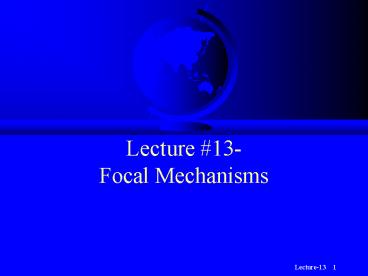Lecture - PowerPoint PPT Presentation
1 / 21
Title:
Lecture
Description:
are associated with the three types of stress regimes: ... The steepness of the fault. Reverse = shallow. Normal = steep. Nearby morphological features ... – PowerPoint PPT presentation
Number of Views:40
Avg rating:3.0/5.0
Title: Lecture
1
Lecture 13- Focal Mechanisms
2
Faulting
- We have learned that the three basic styles of
faulting - Normal
- Reverse
- Strike-slip
- are associated with the three main types of
plate boundaries - Divergent
- Convergent
- Conservative
3
Faulting
- We also have learned that these three mechanisms
- Normal
- Reverse
- Strike-slip
- are associated with the three types of stress
regimes - Extension (vertical stress greater than
horizontal stresses) - Compression (vertical stress less than horizontal
stresses) - Translation (vertical stress in between
horizontal stresses)
4
Faulting
There are special graphics, called focal
mechanisms or beachballs that we use as
shorthand to describe the style of faulting.
5
Faulting and Plate Tectonics
6
Faulting
- So far we have talked about the faulting of
shallow earthquakes, which are well explained by
plate tectonics. - What about the faulting style of deep earthquakes
? - Do similar principles hold true?
7
Faulting
- We sometimes see normal faulting at depths of
100 km or so in subduction zones
Earths surface
The slab can break under the extensional bending
stresses.
8
Faulting
- We sometimes see reverse faulting for the
deepest earthquakes at about 600 km depth
Earths surface
670 km Discontinuity
9
Faulting
- So, what are focal mechanisms (beachballs)
anyway? - Graphical shorthand for a specific faulting
process (strike, dip, slip) - Projections of a sphere onto a circle (the lower
focal hemisphere) - Representations of the first motion of seismic
waves
10
(No Transcript)
11
Focal Mechanism
- When mapping the focal sphere to a circle
(beachball) two things happen - Lines (vectors) become points
- Planes become curved lines
12
(No Transcript)
13
Focal Mechanisms
- Beachballs always have two curved lines
separating the quadrants. That means that
beachballs show two planes. - But there is only one fault plane.
- The other plane is called the auxiliary plane.
- Seismologists cannot tell which is which from
seismograms alone, so we always show both of the
possible solutions.
14
Focal Mechanisms
- Although seismologists cannot tell which plane
ruptured from the seismograms, we can tell the
type of faulting (reverse, normal, strike-slip)
15
Focal Mechanisms
- It is often possible to make an educated guess as
to which of the two possible planes is the actual
fault plane - Normal earthquakes work with gravity so are
often steep - Thrust events work against gravity so are often
shallow
16
A normal faulting mechanism. Which plane do you
think is the fault plane ?
A reverse faulting mechanism. Which plane do you
think is the fault plane ?
17
(No Transcript)
18
(No Transcript)
19
Focal Mechanisms
- For strike slip focal mechanisms we can often
determine the fault plane by its orientation with
respect to the fault.
Ridge
Plate A
Plate B
(right or left lateral ??)
Ridge
20
Summary
- The focal mechanism of an earthquake is a
graphical description of the type of faulting - Although the fault type can be determined from
seismograms, the particular fault plane cannot be
determined. - There are always 2 possibilties
- The real plane, known as the fault plane
- The fake plane, known as the auxiliary plane
21
Summary
- The fault plane can be distinguished from the
auxiliary plane by considering - The steepness of the fault
- Reverse shallow
- Normal steep
- Nearby morphological features
- The strike of the transform segment for instance
- The distribution of aftershocks
- Aftershocks tend to line up along the fault plane
(but not always of course)

